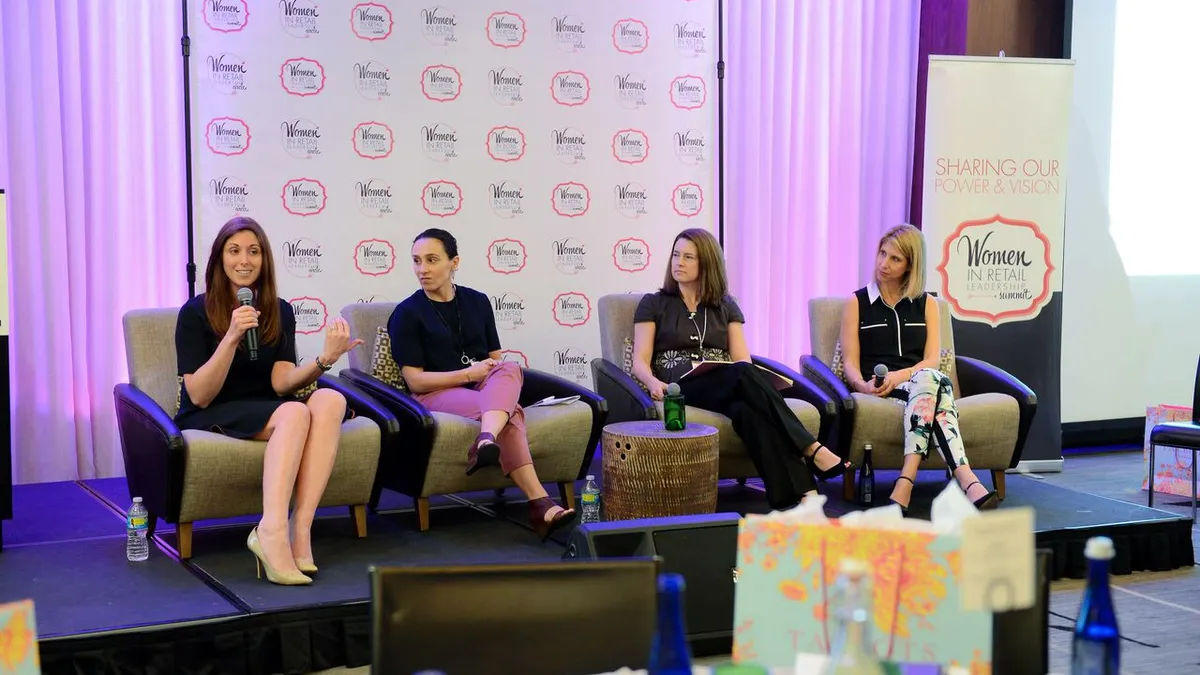Women have long been the backbone of retail.
Traditionally, almost every household purchase went through them, including grocery shopping, home decorating, and buying clothes for the family. Even though society has evolved from the 1950s ideal of "Susy Homemaker"—57% of women participate in the U.S. labor force today—women still dominate spending. According to multiple studies, women drive 70-80% of consumer spending in the U.S. through their purchasing power and influence.
Compare this big influence to the number of women found in retail’s executive ranks and a puzzling discrepancy emerges. While women are directly responsible for many retailers’ sales and successes, they occupy only 5.6% of CEO positions at retail companies in the S&P 500. The percentage of board seats filled by women is better at 19.9%, but it's still far from equal representation.
The lack of women in leadership ranks isn’t exclusive to retail, of course. In fact, women occupied only 4% of CEO positions at S&P 500 companies as of October 2015—meaning, retail is actually ahead of the curve, albeit only by a little bit. But one question cuts to the heart of the problem in retail: In an industry disproportionately powered by the whims of women, are retailers at a disadvantage by not equally representing them in their leadership?
What's the problem?
It's not just retail. Nearly every industry has the same issue: a lack of women in leadership positions. This dearth was the focus of a Pew Research Center study released last year that looked to identify the root causes for the relative lack of women leaders in American business and politics.
According to the survey, 43% of Americans believe that women encounter double standards as they look to rise up the corporate ladder, the most cited reason in the study. This holds true even though the majority of Americans believe women possess the same key leadership traits as men and are better at being honest and ethical in leadership roles.
Looking specifically at retail, Jennifer DiPasquale, co-founder of the Women in Retail Leadership Circle, told Retail Dive that a relative lack of women in leadership may be due to a clog in the talent pipeline. Although women make up more than half of the retail labor force, that number drops precipitously with each level of leadership, according to research firm Catalyst.
“A simple answer may be having more women in the pipeline,” DiPasquale said. “Women need to be groomed for more P&L (profit-and-loss) jobs that pave the way for C-suite roles and opportunities.”
But looking back at the Pew study, the simplest answer may be this: 43% of Americans surveyed by Pew said that corporate America is not ready to put women in leadership positions. This can be discouraging for anyone looking to amend the gender gap: While women can work hard to overcome the double standards they face, an ingrained resistance to hiring female leaders may be something even the hardest work ethic can't fix.
Are retailers at a disadvantage?
If diversity itself isn’t enough motivation for retailers to increase women in their executive ranks, the bottom line might be.
Citing a recent study by Catalyst, DiPasquale pointed out that companies with the highest percentage of women board members outperformed those with the least in certain key metrics, such as return on equity, return on sales, and return on invested capital.
“Women have different skill sets than men, and can bring a unique perspective to any organization,” DiPasquale said. “By nature, women are opportunity experts, and when we find one, we can remain laser focused and not let ego get in the way.”
Katia Beauchamp, CEO of beauty retailer Birchbox, told Retail Dive that having women in leadership positions creates a diverse balance in leadership that in turn offers new perspectives to challenges and opportunities.
“Growth and change comes from challenging our own ideas and preconceptions. We need to challenge our thinking and create opportunities for female leaders,” Beauchamp said. “The retail industry is no different from any industry in its need for diversity at the top, and without it, we aren't realizing the potential of the evolution that needs to take place.”
Diverse perspectives can help typically-male-dominated C-suites connect with and understand their target clientele. In an op-ed written for Business of Fashion, designer Rebecca Minkoff made a plea for more women to work in fashion technology by describing the process of designing a new mirror for her technology-focused store. After months of engineering this undoubtedly pricey interactive mirror, Minkoff said the whole project was derailed after one woman looked into the mirror and pointed out a seemingly obvious flaw: it made her look fat.
“Until that day, despite an extraordinary investment into our vision of building what have been called the ‘store of the future,’ we somehow forgot to properly solicit the opinion of female millennials,” Minkoff wrote. “They simply hadn’t been on the engineering team.”
Minkoff realized that in order to properly cater to her target customer—female millennials—she had to include female millennials in the design process, especially in technology departments, where the absence of women is especially apparent.
While having a female CEO “presented interesting challenges” when fundraising or negotiating with companies that have predominantly male-heavy leadership teams, Beauchamp believes it has also given Birchbox an advantage in relating to female customers.
“Being a female CEO in a company that started as completely oriented towards a female consumer definitely brings authenticity to the product that we create,” Beauchamp said.
What retailers—and women—can do
While it’s all well and good to point out the lack of women in retail leadership positions, the hard part is fixing the issue. In a 2008 report, “Women Matter,” consulting firm McKinsey & Company laid out some steps that companies can take to improve their gender diversity in leadership positions.
The first recommendation mirrors DiPasquale’s call for more women in the pipeline for leadership positions: identifying bottlenecks in the path to promotion that could stem women’s opportunity to advance. If retailers see an uneven ratio of “women eligible for promotion” to “women promoted,” for instance, this is a likely sign that action is needed. Companies can then take steps to address the imbalance, including making sure their recruitment and career management system is “gender-neutral and performance-focused,” and there are measures that can facilitate employees’ flexible working hours and breaks throughout their careers.
“Companies should make space for women to have families and careers — everyone ‘knows’ that, but there’s a disconnect between intellectually understanding that, and how we behave toward a woman who does ‘want it all,’” Beauchamp said. “I could argue that the ambition to have it all should be a great sign to employers.”
Women should have ample opportunities to network and break into the “boys clubs” that make up some of the industry's top brass, according to DiPasquale. “Networking is of the utmost importance in moving ahead in any career,” she said. She encourages women in retail to find mentors, be involved in peer groups, and make their networking “strategic.”
“Determine whom you want to talk to; ask for what you want; and identify what you can offer in return,” DiPasquale said. “In my experience, women aspiring to leadership roles also need to learn the art of strategic influence and persuasion, which, like any skill, takes practice and dedication.”
These skills might help women increasingly break into the top ranks, but it's important for retailers to address the issue, too. If connecting with customers is the foundation of good retail, companies need to include their perspectives in key decisions.
“Retailers are constantly trying to not only retain existing customers, but acquire new ones. Most retailers even refer to customers as ‘she,’” DiPasquale said.
“It makes complete sense to match your executive team to the consumers you're trying to attract,” she continued. “It’s imperative to have a workforce that better matches your customer demographics.”





















